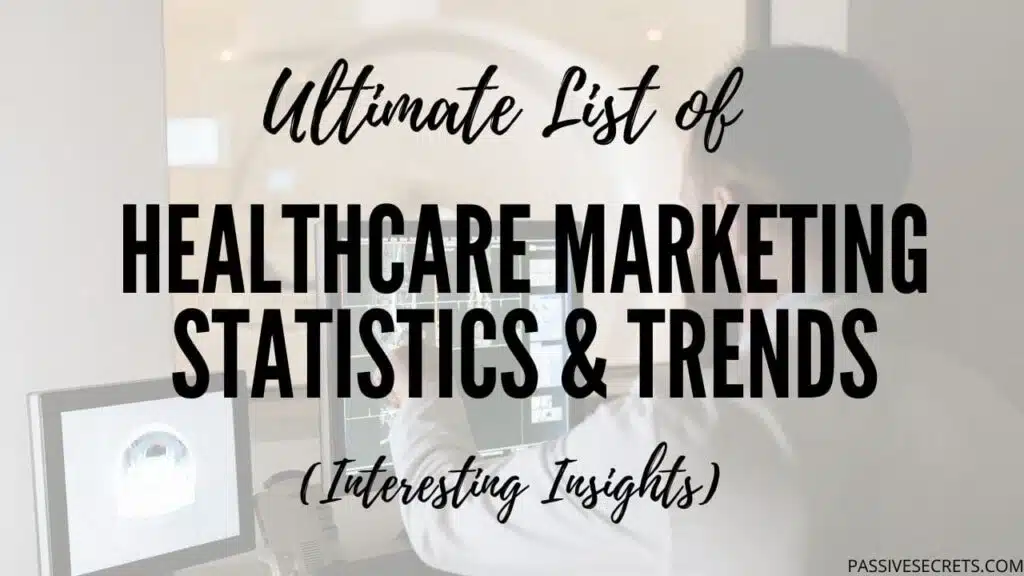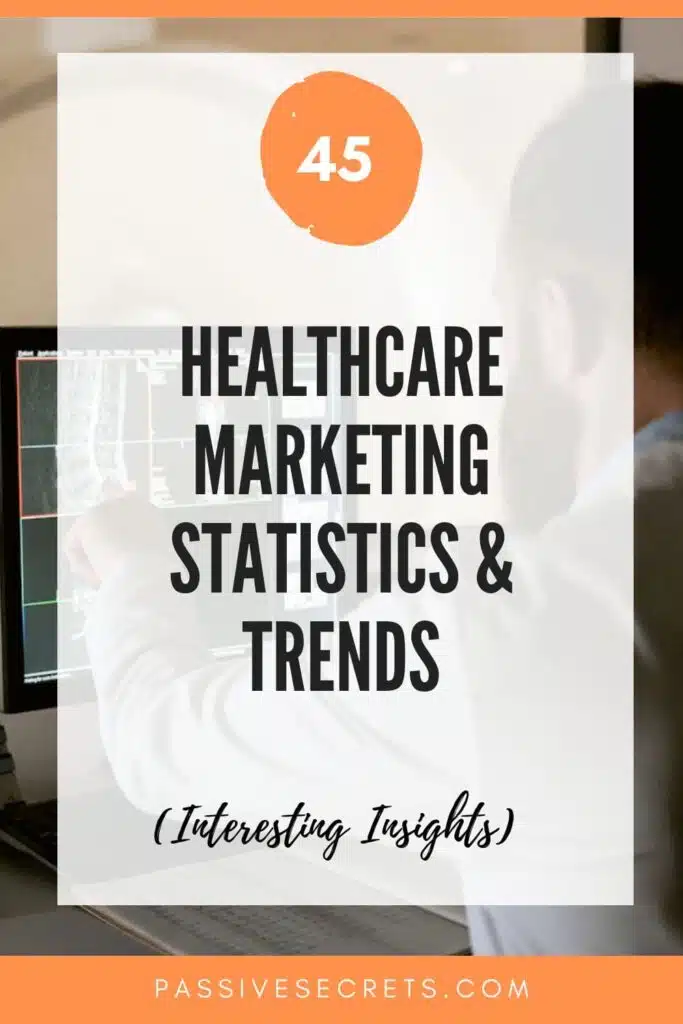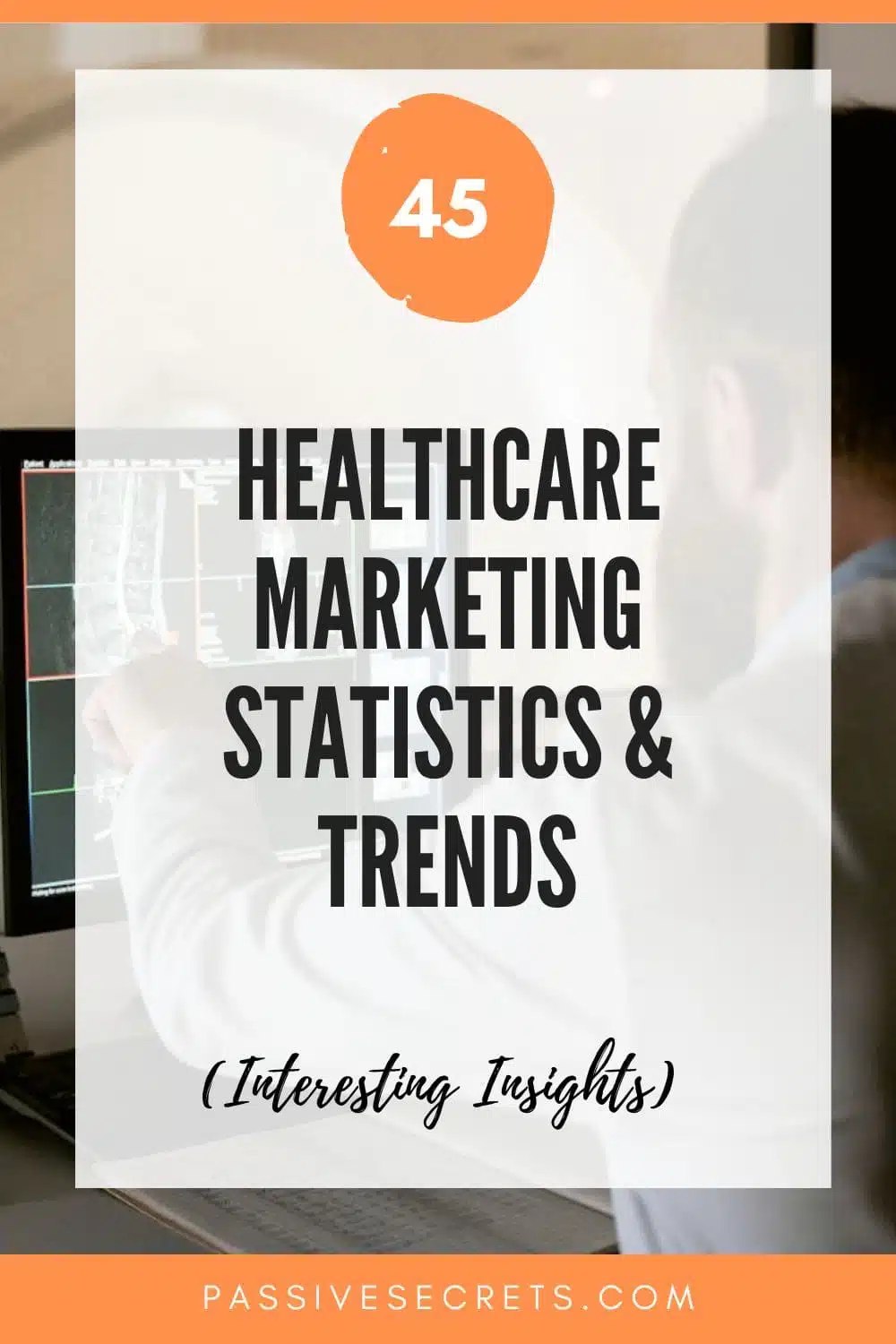
In the healthcare industry, marketing has become vital in connecting patients with the care and services they need.
Just as doctors tailor their approach to each patient, effective healthcare marketing must be equally personalized and responsive to the unique needs and preferences of the target audience.
By understanding the latest trends and statistics in healthcare marketing, we can gain valuable insights into creating meaningful connections, building trust, and improving patient outcomes.
In this article, we’ll explore the data-driven landscape of healthcare marketing and uncover strategies to elevate your organization’s brand and reach.
Key Healthcare Marketing Statistics
- The average hourly wage for Healthcare Marketing in the U.S. was $33.10.
- Healthcare-related email campaigns have an average open rate of 41.2%.
- The North American healthcare advertising market was valued at USD 18.25 billion in 2023 and is anticipated to reach USD 27.58 billion by 2031.
- The UAE’s healthcare sector boasts one of the highest per capita expenditures globally, at $1,200.
- The U.S. healthcare advertising market reached $23.5 billion in 2023 and is expected to grow to $33.8 billion by 2032.
- The global healthcare advertising market is projected to grow at a CAGR of 5.4% between 2024 and 2029, increasing from $42.28 billion in 2024 to $54.99 billion by 2029.
- The mean healthcare company’s marketing budget was USD 9.1 million.
General Healthcare Marketing Statistics
1. Healthcare marketers reported the following digital marketing channel usage: social media (93%), paid search (89%), and email marketing (83%). (source)
2. As of May 28, 2024, the average hourly wage for Healthcare Marketing in the U.S. was $33.10. (source)
3. Some identified cities where Healthcare Marketing salaries exceed the national average include Home, WA, Berkeley, CA, and New York City, NY, leading the list. New York City’s average is $11,300 (16.4%) above the national average, and Home, WA, exceeds it by $16,434 (23.9%). (source)
4. In 2023, marketers shifted their focus to engaging doctors through digital channels, with a significant increase in non-linear TV (53.4% vs 29.5% in 2022), digital advertising, and mobile/tablet apps. Meanwhile, traditional methods like in-person sales reps and professional meetings/conferences saw a decline. (source)
5. According to ZipRecruiter, Healthcare Marketing hourly wages range from $18.99 to $57.69, with the majority falling between $19.71 (25th percentile) and $54.09 (75th percentile) across the U.S. (source)
The wide pay range for Healthcare Marketing, differing by as much as $34.38, suggests numerous opportunities for career advancement and higher pay based on skill, location, and experience.
6. Over 40% of healthcare marketers do not utilize essential marketing technologies like marketing automation and call tracking. (source)
7. 82% of healthcare marketers do not employ technological tools such as conversion rate optimization tools, and 47% do not use a customer relationship management (CRM) system. (source)
8. Only 30% of respondents plan telehealth-related projects or initiatives. As the pandemic recedes, investment in telehealth is expected to decline further. (source)
9. Approximately 7% of daily searches on Google are related to health, as stated by the Vice President of Google Health. This means that Google receives about 1 billion health-related daily searches. (source)
10. According to research done, Google’s daily searches for health-related information total 70,000 every minute. (source)
11. The growing trend of personalized medicine increases the need for specialized advertising strategies. (source)
12. The swift advancements in medical technology create abundant opportunities for healthcare advertising. (source)
13. Advertising campaigns that promote healthcare access and equity are crucial in reducing disparities and improving health outcomes for marginalized groups. (source)
14. South Africa dominates the healthcare advertising market in the Middle East and Africa, driven by investments in healthcare infrastructure, increased advertising efforts by providers, growth of telehealth, and rising disposable income. (source)
15. Healthcare-related email campaigns have an average open rate of 41.2%. (source)
16. Nearly 60% of US adults searched online for health information, 42% communicated with healthcare providers, and 46% checked medical test results online. (source)
17. 87% of healthcare marketers say their top marketing goal is to increase patient volume. 53% aim to build brand awareness, and 42% want to improve customer loyalty. (source)
Healthcare Marketing Industry Statistics
18. The North American healthcare advertising market was valued at USD 18.25 billion in 2023 and is anticipated to reach USD 27.58 billion by 2031, with a CAGR of 5.30% between 2024 and 2031. (source)
19. The Middle East and Africa healthcare advertising market was valued at USD 15.34 billion in 2021 and is predicted to reach USD 20.04 billion by 2029, growing at a CAGR of 3.40% from 2022 to 2029. (source)
20. For 2023, OTC (over-the-counter) drug dealers’ sales in the U.S. were estimated to surpass 43 billion dollars, a notable rise from approximately 28 billion dollars in 2011. Popular OTC products include vitamins, cold/allergy tablets, and internal pain relievers. (source)
21. As the UAE’s largest city, Dubai commands a significant portion of the nation’s healthcare market and was expected to grow at an annual rate of 10% from 2019 to 2023. (source)
22. The UAE’s healthcare sector boasts one of the highest per capita expenditures globally, at $1,200. The industry generates annual revenues exceeding $4.63 billion, with 75 insurance companies offering over 12,000 policies, making it a significant and diverse market. (source)
23. The UAE’s medical device market is projected to reach AED 5.6 billion by 2025, growing at an annual rate of 4.4% from 2020 to 2025. (source)
24. According to IMARC Group, the U.S. healthcare advertising market reached $23.5 billion in 2023, and it is expected to grow to $33.8 billion by 2032, with a 4% annual growth rate from 2024 to 2032. (source)
25. The European healthcare advertising market is projected to grow from $10.93 billion to $16.15 billion by 2029, representing a compound annual growth rate (CAGR) of 5.0%. (source)
26. The global digital out-of-home (OOH) advertising market, valued at $63.36 billion in 2022, is projected to reach $153.55 billion by 2030, growing at a compound annual growth rate (CAGR) of 11.7% from 2023 to 2030. (source)
27. The global healthcare advertising market is projected to grow at a CAGR of 5.4% between 2024 and 2029, increasing from $42.28 billion in 2024 to $54.99 billion by 2029. (source)
28. In the pharma and health industry, AI applications are primarily used for data analysis and market research (35% and 32%, respectively), followed by copywriting (20%) and image generation (12%). (source)
Healthcare Marketing Spend
29. In 2022, US healthcare marketers devoted a significant portion of their marketing budgets to digital ads (12.5%), social media (11.5%), and traditional ads (9.5%). (source)
30. In 2022, the U.S. was the leading national pharmaceutical market, accounting for over 42% of global pharmaceutical spending. China was the second-largest, covering around 8% of the hospital market. (source)
31. In 2023, the mean healthcare company’s marketing budget was USD 9.1 million. (source)
32. In 2023, the average marketing expenditure for a biotech company in the United States was $10.9 million. The average for pharmaceutical and medical device companies was $8.8 million and $8 million, respectively. (source)
33. The US spent around $574 billion on prescription medications in 2022, marking a significant healthcare expenditure. (source)
34. Australia’s healthcare industry saw a significant boost in magazine advertising spending in 2021, with a 23.95% increase of $1.1 million compared to the previous year, marking the first upward trend in advertising expenditure during the observed period. (source)
35. 7 out of 10 pharmaceutical companies analyzed prioritized marketing and sales expenditures over research and development, with a staggering $36 billion (37%) more spent on promotion than innovation. (source)
36. In 2021, South Africa’s healthcare market spent $1.8 million on out-of-home ads, a 30% increase from 2020 but still lower than the $2.3 million spent in 2019. (source)
37. The healthcare industry’s spending on magazine ads in South Africa decreased by 57% between 2019 and 2021, from $4.8 million to $2 million. (source)
Healthcare Marketing Concerns
38. The North American healthcare industry faces significant challenges due to high external marketing expenses, which impede market growth. Outbound marketing costs range from $10 to $34 CPM, far exceeding the $1.54 to $10.00 CPM for inbound marketing. (source)
39. Around 75% of participants reported exposure to false or inaccurate health or medical information, while 16% were uncertain if they had encountered such misinformation. (source)
40. 82% of individuals who encountered medical misinformation reported seeing it on social media platforms. 60% said they saw it from an internet search. (source)
41. According to a study, nearly 40% of COVID-19-related social media posts, totaling over 45 million out of 112 million, were traced back to untrustworthy sources. (source and source)
42. Healthcare marketers face significant barriers to achieving their marketing goals, with 57% citing staffing shortages (up 12% from 2021), 35% lacking sufficient funds (up 10%), and 27% struggling with technology implementation. (source)
Healthcare SEO Marketing Statistics
43. Healthcare marketers have regained confidence, with 64% of respondents rating their digital marketing strategies as “effective” or “most effective” (4-5 on a 1-5 scale), indicating a sense of stability and optimism in their marketing efforts. (source)
44. Healthcare marketers ranked SEO (37%) and PPC (34%) as the most effective marketing strategies, surpassing social media, display advertising, and video. (source)
Only 35% of respondents felt they were very successful at tracking ROI. The ability to easily measure performance and attribute results makes SEO and PPC more appealing to marketers.
45. While most healthcare marketers (69%) have an SEO strategy in place, only a small fraction (20%) believe it is highly effective in attracting new patients, indicating a gap between SEO efforts and desired outcomes. (source)
Nearly half of healthcare marketers (46%) consider their SEO strategies somewhat effective, while the remaining 34% are uncertain about their impact.
46. Most healthcare groups use Google Ads (62%) and Facebook Ads (58%) to target high-intent patients. While 73% find paid media effective for attracting new patients, investments are shifting: video and display ads are decreasing (-24% and -22%, respectively). (source)
Latest Healthcare Marketing Trends For 2024 and Beyond
1. The Acceleration of Patient Empowerment and Consumerism
The healthcare landscape is transforming profoundly as patients increasingly take charge of their care and make informed health decisions. This shift is driven by the rise of wearable technology and health tracking and the growth of online communities and support groups.
Patients are no longer passive recipients of care but rather active participants who expect to be engaged in their health management. This consumer-driven approach to healthcare is fueled by the availability of high-deductible health plans, price transparency initiatives, and online reviews and ratings.
As a result, healthcare marketers must adapt their strategies to meet patients’ evolving needs and expectations. This requires a patient-centric approach prioritizing transparency, trust-building, and digital engagement.
Healthcare marketers can help deliver a more personalized and effective healthcare experience by emphasizing innovation, patient outcomes, and value-driven care.
Ultimately, this shift has the potential to revolutionize the healthcare industry, putting patients at the forefront of care and improving outcomes for all.
2. Patient-Centric Healthcare Marketing
The patient’s journey is a comprehensive and multifaceted experience that extends far beyond the clinical encounter.
Healthcare marketers must recognize the significance of the patient journey and invest in employee training, streamlined administrative processes, and enhanced facility aesthetics.
Emphasizing convenience through digital solutions and gathering patient feedback is also crucial. Marketing efforts must align with the reality of the patient experience, avoiding exaggerated claims that may lead to disappointment.
By prioritizing the patient journey, healthcare providers can deliver a holistic, positive experience that builds trust, loyalty, and a strong brand reputation. The patient’s journey is not just about medical treatment; it’s about delivering care with empathy, respect, and comfort.
Healthcare marketers can create a comprehensive strategy that truly resonates with patients by acknowledging and addressing the various touchpoints influencing brand perception.
3. Patient-Centered Language Takes Center Stage
The healthcare industry is shifting towards patient-centered language, prioritizing clarity and simplicity in communication.
Disruptors investing in healthcare content have raised the bar, and traditional systems must adapt to meet patient needs.
Ahava Leibtag’s keynote highlights the importance of patient-centered language, emphasizing that complexity does not equal authority.
Most adults struggle with health literacy, and emotional situations like health scares make complex language harder to understand. Marketers should use plain language, active voice, and everyday words to make content digestible.
Tips include using headings, bullet points, pictures, and metaphors to simplify content.
Auditing existing content, researching disruptor brands, reviewing blog content, and appointing a plain language champion can help healthcare marketers adopt patient-centered language.
By making language more accessible, healthcare providers can differentiate themselves and attract patients seeking clear and compassionate communication.
4. Getting Comfortable with the Uncomfortable: The Role of AI in Healthcare
The use of AI in healthcare marketing requires a cautious approach, as the industry prioritizes trust and accuracy over efficiency.
While AI can assist with content creation, research, and SEO strategies, its limitations and potential for false information must be acknowledged.
Healthcare marketers should leverage AI for internal purposes, such as research and content ideation, but exercise extreme care when using it for consumer-facing content.
Chatbots and virtual assistants can enhance customer service, while AI integration into backend operations can streamline administrative tasks.
However, human oversight and fact-checking remain essential to deliver accurate and trustworthy healthcare information.
Healthcare marketers can harness AI’s potential by balancing innovation and responsibility while maintaining their brands’ trust and reputation.
5. Navigating the Unyielding Workforce Challenges in Healthcare
The healthcare industry has faced persistent workforce challenges since the 1930s, and the post-COVID labor market has intensified the issue.
The shortage of healthcare professionals, particularly nurses and physicians, has reached critical levels, compromising patient care and safety.
To address this, healthcare institutions, governments, and educational bodies must collaborate to increase enrollment in nursing schools, prevent burnout, and prioritize staffing levels.
Marketers have a crucial role in attracting and retaining healthcare professionals by forming partnerships with colleges, launching cooperative marketing campaigns, and highlighting the rewarding aspects of the profession.
By working together, we can build a sustainable healthcare workforce that prioritizes patient care and safety. The key takeaways are:
- Increase enrollment in nursing schools
- Prevent burnout and prioritize well-being
- Prioritize staffing levels and effective workforce management
- Form partnerships with colleges and universities
- Launch cooperative marketing campaigns
- Highlight the rewarding aspects of the profession
Addressing these challenges can ensure a robust and sustainable healthcare workforce that delivers quality patient care and improves healthcare outcomes.
Conclusion
The healthcare industry is dynamic and changing rapidly, and marketing has never been more crucial.
By staying informed about the latest healthcare marketing statistics and trends, you can develop targeted strategies that resonate with your patients and drive meaningful engagement.
Whether leveraging digital platforms, optimizing your online presence, or fostering personal connections, the key is to put the patient at the center of your marketing efforts.
Doing so can attract new patients, cultivate lasting relationships, and build a reputation as a trusted healthcare provider.
Effective healthcare marketing creates a human-centric experience that empowers patients and elevates the entire healthcare ecosystem.
Frequently Asked Questions
What is the target audience in healthcare marketing?
The target audience can include direct consumers and those who make purchase decisions or influence them. Such people are called decision-makers or reference groups. For example, doctors are a reference group for patients when buying medicines.
How do you measure success in healthcare marketing?
Different metrics can be used to measure success in healthcare marketing, including measuring return on Investment (ROI), Understanding Patient Acquisition Cost (PAC), calculating Patient Lifetime Value (LTV), monitoring Patient Calls, tracking Search Engine Ratings, and improving Your Star Rating.
What is the largest market for healthcare?
The US is the world’s largest healthcare market, even though growth in the US has become significantly restricted.

Other Marketing Statistics You Should Know:
- B2B Sales Statistics: Latest Insights and Trends
- 50+ Essential Traditional Marketing Statistics & Trends
- 60+ QR Code Statistics, Usage, Forecasts & Trends
- 90+ Useful Marketing Jobs Statistics & Facts (Latest Report)
- Sales Enablement Statistics: Data You Need to Drive Sales Growth
- In-store vs Online Shopping Statistics And Analysis
- Social Media Addiction Statistics
- Latest In-Game Advertising Statistics
- From Passion to Profit: 120+ Creator Economy Statistics
- 80+ Big Marketing Software Statistics
- Print Marketing Statistics: Ad Spending, Market Size, & More
- Key Short-Form Video Statistics and Trends You Should Know
- 49 Interesting Emotional Marketing Statistics
- 90 Amazing Millionaire Statistics
- 70+ Top Law Firm Marketing Statistics & NEW Trends
- Millennials on Social Media Statistics
- 23 Most Interesting First Impression Statistics To Know
- 60+ Interesting Storytelling Statistics, Facts & Huge Trends
- Amazon Book Sales Statistics: Intriguing Numbers and Facts
- 61+ Useful Podcast Advertising Statistics And Trends
- 50+ Useful Call Center Statistics And Trends
- 50 Crucial Amazon Advertising Statistics & Trends
- 65+ Must-Know Pay-Per-Click Statistics
- 40+ Interesting Omnichannel Marketing Statistics & Trends
- Multi-Level And Network Marketing Statistics, Facts & Trends
- Virtual Event Statistics & Benchmarks For Marketers & Organizers
- 55 Interesting Direct Mail Marketing Statistics and Trends
- B2B Lead Generation Statistics, Facts, Trends, Benchmarks, & Market Size
- 52 Valuable Trade Show Statistics and Trends
- 100+ Top Digital Marketing Vs. Traditional Marketing Stats
- 110+ Important Social Media Advertising Statistics & Trends
- 50 Interesting Organic Vs Paid Search Statistics To Know
- 41+ MOST Important Copywriting Statistics To Know
- 80+ Useful Sales Funnel Statistics & Conversion Rates
- 40+ Latest Multi-Channel Marketing Statistics & Huge Trends

